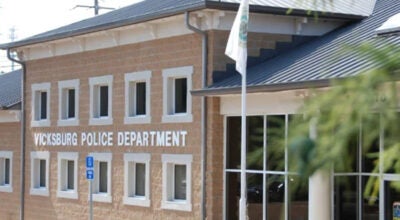Books at library highlight Civil War, Hurricane Katrina
Published 11:51 am Thursday, December 10, 2015
This week, the Warren County-Vicksburg Public Library is featuring books about the Civil War and Hurricane Katrina.
“Katrina: After the Flood” is a book by Gary Rivlin. When Hurricane Katrina made landfall in southeast Louisiana on August 29, 2005, it left in its wake a ruined city that is still coming to terms with the devastation. Rivlin traces the immediate damage caused by the storm, New Orleans’s efforts to rebuild itself, as well as the lasting effects left on the city’s geography, infrastructure, and its psychic, racial, and social fabric. After the storm, four of every five houses were flooded; schools and businesses were wrecked; and the city’s infrastructure—water, sewage, electricity, and transportation—was in ruins. By interviewing civic leaders, elected officials, business owners, teachers, doctors, and construction workers, the author builds a picture of what it has taken to get New Orleans to where it is now. Rivlin relates how these resilient people have confronted the consequences and either restored, altered, or abandoned their city.
“The War That Forged a Nation: Why the Civil War Still Matters” is by James McPherson. Six generations have now passed since the Civil War pitted brother against brother; yet, Americans are still struggling with how this brutal war has influenced and shaped the country. In this book, McPherson considers why the Civil War is still so deeply engrained in our national consciousness. The shear scope and size of the war—an estimated 750,000 dead, not including civilians—still boggles the mind. Not only that, but the war brought mythological status to many of its key players—Abraham Lincoln, Robert E. Lee, Ulysses S. Grant, Frederick Douglass, Clara Barton, and Stonewall Jackson to name a few. McPherson takes the study of the war beyond its death toll, heroes, and villains. He explains the connection between the Civil War and civil rights. He also tells how modern divisions and problems—racial inequality, political gridlock, regional conflict, Red States and Blue States, questions of state sovereignty, and the sometimes violent disagreement about what role government should play in social change—can be linked to the legacy of the Civil War.
“The Civil War: A Visual History” is published by the Smithsonian and DK Books. Arranged chronologically, this encyclopedia of the events of the Civil War begins with the events that lead up to the succession of the southern states as well as the battles and major players during the war. There are full color prints, examples of propaganda from both sides, and color photos of artifacts from the war itself—for example, you’ll see the oak tree felled by gunfire which is now located in the Smithsonian. You will also find photos of generals with timelines of their careers, their histories, and their lives after the war. This is a good general overview of the Civil War, its causes, and its aftermath.
“We’re Still Here Ya Bastards: How the People of New Orleans Rebuilt Their City” is a book by Roberta Brandes Gratz. The aftermath of Hurricane Katrina is a dark cloud of government neglect and socioeconomic inequality that turned a crisis into a tragedy. The people of New Orleans, however, managed to find hope among the rubble. This is the story of those people who returned to New Orleans and took the task of rebuilding the city into their own hands. The author shows how the city—from the Lower Ninth Ward to the French Quarter and Bayou Bienvenue—is recovering in spite of flawed government policies that have turned out to promote “disaster capitalism” rather than public good. Gratz also takes a look at some of the most hotly debated issues and challenges facing the city: a violent and corrupt prison system, the tragedy of closing the Charity Hospital, the future of the educational system, and the rise of gentrification. These stories have often been ignored by the mainstream media, but they demonstrate the hope and resilience of a community that is still working to rebuild their beloved New Orleans.
“Vicksburg: Fall of the Confederate Gibraltar” is by Terrence J. Winschel (who is retired from the Vicksburg National Military Park). Right from the beginning of the Civil War, Vicksburg stood out as a Confederate stronghold along the all-important Mississippi River.
By 1863—and in spite of Federal success in both New Orleans and Memphis—Vicksburg was defiant and keeping the supply line from the Trans-Mississippi West to the major Confederate armies in the East. That year, however, Ulysses S. Grant launched a campaign to topple the “Confederate Gibraltar.” General John C. Pemberton’s Confederate troops desperately held on to this river town expecting relief that never came.
“Ghosts and Haunts of the Civil War” is a book by Christopher K. Coleman. It is no doubt that war leaves a mark on the land, the people, and, most definitely, the soldiers that fight. But, do those scars remain in death? The American Civil War was full of bloody battles that left a great many soldiers and civilians dead, but what about the stories that don’t make it to the history books: ghost soldiers haunting long-forgotten battlefields, phantom drummer boys rapping out audible rhythms on invisible drums, and the spirits of executed abolitionists who still pursue their righteous crusades. This book is a compilation of these and other unexplained phenomenon rooted in history and witnessed by people from the present day.
Like the Civil War itself, the eerie descriptions of spirit sightings and ghostly reenactments involve people from all walks of life: soldiers and civilians, slaves and owners, celebrities and ordinary people.
•
Evangeline Cessna is local history librarian and the Warren County-Vicksburg Public Library.





